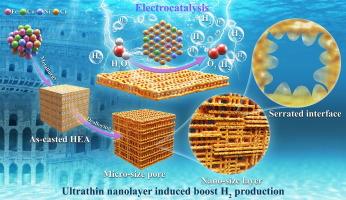Ultrathin heterogeneous nanolayer structure of FeCoNiCu multi-principal element alloy for robust water electrolysis
IF 13.3
1区 工程技术
Q1 ENGINEERING, CHEMICAL
引用次数: 0
Abstract
Developing efficient, cost-effective alloy catalysts for the hydrogen evolution reaction (HER) is a promising strategy to convert electrical energy to chemical fuels efficiently, however, it remains challenge. Herein, a designed non-equimolar FeCoNiCu multi-principal element alloys (MPEAs) catalyst, fabricated via a simple physical metallurgy and chemical dealloying, exhibits HER performance comparable to commercial noble metal counterpart. The optimal (FeCoNi)70Cu30 (at.%) catalysts display a remarkable minimum overpotential of 34 mV (@10 mA cm−2) and a Tafel slope of 48 mV dec-1. Meanwhile, the electrocatalyst exhibits excellent 24 h long-term durability stability at a high current density of −500 mA cm−2. This is attributed to the multi-scale substructure of distinctive, self-supporting Colosseum-inspired skeletal structure, coupled with nanoscale porous architecture attached to ultra-thin serrated amorphous nanolayer structure, significantly enhancing the specific surface and active sites. This study provides a novel strategy for designing high-performance non-precious metal catalysts with heterogeneous substructures based on multicomponent combinations.

求助全文
约1分钟内获得全文
求助全文
来源期刊

Chemical Engineering Journal
工程技术-工程:化工
CiteScore
21.70
自引率
9.30%
发文量
6781
审稿时长
2.4 months
期刊介绍:
The Chemical Engineering Journal is an international research journal that invites contributions of original and novel fundamental research. It aims to provide an international platform for presenting original fundamental research, interpretative reviews, and discussions on new developments in chemical engineering. The journal welcomes papers that describe novel theory and its practical application, as well as those that demonstrate the transfer of techniques from other disciplines. It also welcomes reports on carefully conducted experimental work that is soundly interpreted. The main focus of the journal is on original and rigorous research results that have broad significance. The Catalysis section within the Chemical Engineering Journal focuses specifically on Experimental and Theoretical studies in the fields of heterogeneous catalysis, molecular catalysis, and biocatalysis. These studies have industrial impact on various sectors such as chemicals, energy, materials, foods, healthcare, and environmental protection.
 求助内容:
求助内容: 应助结果提醒方式:
应助结果提醒方式:


